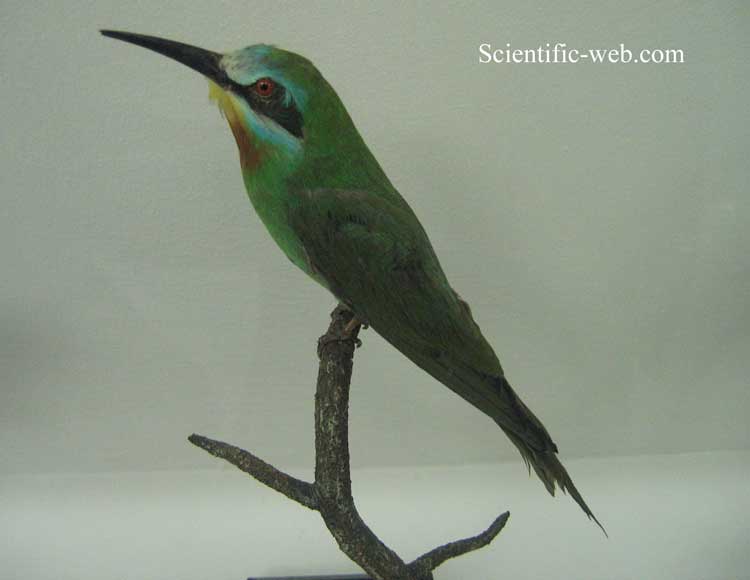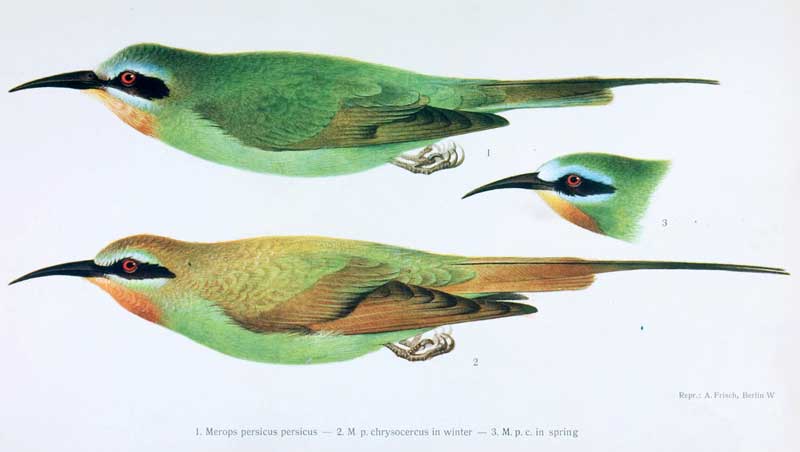
Merops persicus, Photo: Michael Lahanas
Superregnum: Eukaryota
Cladus: Unikonta
Cladus: Opisthokonta
Cladus: Holozoa
Regnum: Animalia
Subregnum: Eumetazoa
Cladus: Bilateria
Cladus: Nephrozoa
Superphylum: Deuterostomia
Phylum: Chordata
Subphylum: Vertebrata
Infraphylum: Gnathostomata
Megaclassis: Osteichthyes
Cladus: Sarcopterygii
Cladus: Rhipidistia
Cladus: Tetrapodomorpha
Cladus: Eotetrapodiformes
Cladus: Elpistostegalia
Superclassis: Tetrapoda
Cladus: Reptiliomorpha
Cladus: Amniota
Classis: Reptilia
Cladus: Eureptilia
Cladus: Romeriida
Subclassis: Diapsida
Cladus: Sauria
Infraclassis: Archosauromorpha
Cladus: Crurotarsi
Divisio: Archosauria
Cladus: Avemetatarsalia
Cladus: Ornithodira
Subtaxon: Dinosauromorpha
Cladus: Dinosauriformes
Cladus: Dracohors
Cladus: Dinosauria
Ordo: Saurischia
Cladus: Eusaurischia
Subordo: Theropoda
Cladus: Neotheropoda
Cladus: Averostra
Cladus: Tetanurae
Cladus: Avetheropoda
Cladus: Coelurosauria
Cladus: Tyrannoraptora
Cladus: Maniraptoromorpha
Cladus: Maniraptoriformes
Cladus: Maniraptora
Cladus: Pennaraptora
Cladus: Paraves
Cladus: Eumaniraptora
Cladus: Avialae
Infraclassis: Aves
Cladus: Euavialae
Cladus: Avebrevicauda
Cladus: Pygostylia
Cladus: Ornithothoraces
Cladus: Ornithuromorpha
Cladus: Carinatae
Parvclassis: Neornithes
Cohors: Neognathae
Cladus: Neoaves
Ordo: Coraciiformes
Familia: Meropidae
Genus: Merops
Species: Merops persicus
Subspecies: M. p. chrysocercus – M. p. persicus
Name
Merops persicus Pallas, 1773
Synonymy
Merops superciliosus persicus

1. Merops persicus persicus Pallas, 1773
2., 3. Merops persicus chrysocercus Cabanis & Heine, 1860
References
Reise durch verschiedene Provinzen des Russischen Reichs 2: 708.
Vernacular names
Afrikaans: Blouwangbyvreter
العربية: وروار أزرق الخد
azərbaycanca: Yaşıl qızlarquşu
brezhoneg: Gwespetaer-Persia
català: Abellerol de Pèrsia
čeština: Vlha modrolící
Cymraeg: Gwenynysor bochlas
dansk: Grøn Biæder
Deutsch: Blauwangenspint
Ελληνικά: Πράσινος μελισσοφάγος
English: Blue-cheeked Bee-eater
Esperanto: Persa abelmanĝulo
español: Abejaruco persa
euskara: Erle-txori papargorri
فارسی: زنبورخوار گلوخرمایی
suomi: Vihermehiläissyöjä
français: Guêpier de Perse
Gaeilge: Beachadóir Peirseach
עברית: שרקרק ירוק
magyar: Zöld gyurgyalag
հայերեն: Կանաչ մեղվակեր
italiano: Gruccione egiziano
日本語: ルリホオハチクイ
қазақша: Жасыл аражегіш
ಕನ್ನಡ: ನೀಲಿ ಕೆನ್ನೆಯ ಕಳ್ಳಿಪೀರ
Nederlands: Groene Bijeneter
norsk: Blåkinnbieter
polski: Żołna modrolica
پنجابی: نیلیاں گلاںوالا مکھی کھانا
português: Abelharuco-persa
русский: Зелёная щурка
svenska: Grön biätare
Türkçe: Yeşil arı kuşu
українська: Бджолоїдка зелена
中文: 蓝颊蜂虎
The blue-cheeked bee-eater (Merops persicus) is a near passerine bird in the bee-eater family, Meropidae. The genus name Merops is Ancient Greek for "bee-eater", and persicus is Latin for "Persian".[2]
It breeds in Northern Africa, and the Middle East from eastern Turkey to Kazakhstan and India. It is generally strongly migratory, wintering in tropical Africa, although some populations breed and live year-round in the Sahel.[3] This species occurs as a rare vagrant north of its breeding range, with most vagrants occurring in Italy and Greece.
Taxonomy and systematics
Two subspecies are recognized:
Merops persicus persicus - Breeds in Asia, winters in East and Southern Africa.
Merops persicus chrysocercus - Breeds in North Africa, winters in West Africa.
This species is closely related to blue-tailed bee-eater, M. philippinus of East Asia, and the olive bee-eater of Africa, and has been treated as being the same species (conspecific).[3]
Description
This species, like other bee-eaters, is a richly coloured, slender bird. It is predominantly green; its face has blue sides with a black eye stripe, and a yellow and brown throat; the beak is black. It can reach a length of 31 cm (12 in), with the two elongated central tail feathers adding another 7 cm (2.8 in). Sexes are mostly alike but the tail-streamers of the female are shorter.[3]
This is a bird which breeds in sub-tropical semi-desert with a few trees, such as acacia. It winters in open woodland or grassland. As the name suggests, bee-eaters predominantly eat insects, especially bees, wasps and hornets, which are caught in the air by sorties from an open perch. However, this species probably takes more dragonflies than any other food item. Its preferred hunting perch is telephone wires if available.
Blue-cheeked bee-eaters may nest solitarily or in loose colonies of up to ten birds. They may also nest in colonies with European bee-eaters. The nests are located in sandy banks, embankments, low cliffs or on the shore of the Caspian Sea. They make a relatively long tunnel of 1 to 3 m (3.3–9.8 ft) in length in which the four to eight (usually six or seven), spherical white eggs are laid. Both the male and the female take care of the eggs, although the female alone incubates them at night. Incubation takes 23–26 days.[3]
The call sounds 'flatter' and less 'fluty' than the European bee-eater.
Blue-cheeked bee-eater eggs
Blue-cheeked bee-eater with dragon fly kill
References
BirdLife International (2019). "Merops persicus". IUCN Red List of Threatened Species. 2019: e.T22683740A155514718. doi:10.2305/IUCN.UK.2016-3.RLTS.T22683740A155514718.en. Retrieved 11 November 2021.
Jobling, James A (2010). The Helm Dictionary of Scientific Bird Names. London: Christopher Helm. pp. 251, 299. ISBN 978-1-4081-2501-4.
Fry, Hilary (2001). "Family Meropidae (Bee-eaters)". In del Hoyo, Josep; Elliott, Andrew; Sargatal, Jordi (eds.). Handbook of the Birds of the World. Volume 6, Mousebirds to Hornbills. Barcelona: Lynx Edicions. p. 337. ISBN 978-84-87334-30-6.
Retrieved from "http://en.wikipedia.org/"
All text is available under the terms of the GNU Free Documentation License

